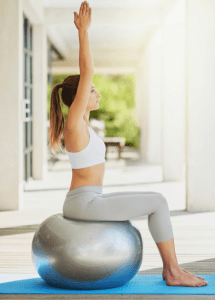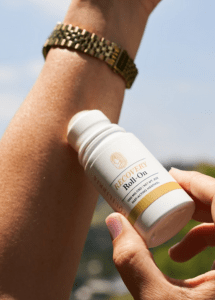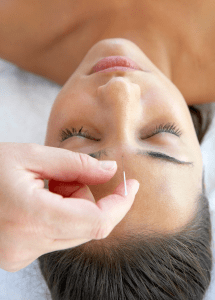EQ Relief Primer

Dealing with persistent aches and pains can make even the simplest tasks feel like daunting challenges. Turns out, you’re not alone. The CDC has estimated that 50 million American adults experience chronic pain. [1] But it doesn’t have to be that way! This EQ Pain Primer introduces a range of strategies that can help you manage and minimize chronic pain and reclaim control over your well-being.
Step 1: Identify the main source(s) of your pain
 It can be difficult to determine effective strategies for pain management if you don’t know exactly what you’re up against. Is the source of your discomfort an injury or medical condition? Is it potentially caused by posture or lifestyle? Could it be muscle tension due to stress or exercise? It’s equally important to identify your triggers. What makes you feel better? What makes you feel worse? Triggers are not always obvious, so it can be helpful to journal or utilize a symptom tracker like Bearable in order to identify what might be contributing to heightened pain levels.
It can be difficult to determine effective strategies for pain management if you don’t know exactly what you’re up against. Is the source of your discomfort an injury or medical condition? Is it potentially caused by posture or lifestyle? Could it be muscle tension due to stress or exercise? It’s equally important to identify your triggers. What makes you feel better? What makes you feel worse? Triggers are not always obvious, so it can be helpful to journal or utilize a symptom tracker like Bearable in order to identify what might be contributing to heightened pain levels.
Step 2: Start Simple, Embrace the Basics
 Before diving into more specific pain management techniques, first make sure that you have a handle on your foundational wellness basics. Are you drinking enough water throughout the day, eating a balanced diet, and prioritizing a good night’s rest? There’s a reason why doctors never cease to make those recommendations when addressing a vast majority of health concerns! Try using apps like Nutrilio which allow you to get reminders to drink water and keep a food journal, and track the quality of your sleep with apps like Sleep as Android or Sleep Cycle.
Before diving into more specific pain management techniques, first make sure that you have a handle on your foundational wellness basics. Are you drinking enough water throughout the day, eating a balanced diet, and prioritizing a good night’s rest? There’s a reason why doctors never cease to make those recommendations when addressing a vast majority of health concerns! Try using apps like Nutrilio which allow you to get reminders to drink water and keep a food journal, and track the quality of your sleep with apps like Sleep as Android or Sleep Cycle.
Step 3: Focus on Movement
 Everyone’s mobility accessibility is different, so find a type of movement that’s right for you and your unique needs! Movement and exercise can help improve joint mobility, reduce inflammation, and release endorphins which are natural pain-relieving chemicals in the body. [2] Consider small ways you can increase your movement throughout the day, such as:
Everyone’s mobility accessibility is different, so find a type of movement that’s right for you and your unique needs! Movement and exercise can help improve joint mobility, reduce inflammation, and release endorphins which are natural pain-relieving chemicals in the body. [2] Consider small ways you can increase your movement throughout the day, such as:
- Take active breaks: If you often sit throughout your workday or at home, set a timer to get up and move or stretch every 20-30 minutes in order to reduce tension and ease discomfort.
- Go for a stroll: Go for short walks as often as you’re able to — the movement and fresh air can have positive impacts on your mental and physical well-being.
- Dance it out: Move your body to some upbeat music, even if it’s just for one song! Your body will thank you for this fun form of exercise, and give you a boost to your mood.
- Park further away: When running errands or going to work, park your car farther away from the entrance to increase the number of steps you take throughout the day.
- Liven up your TV time: Stretch or do gentle exercises while watching TV, and consider using commercial breaks or slower parts of a show to incorporate stretching or gentle exercises.
*If more movement or exercise might risk increasing your pain, be sure to consult your healthcare provider before adding it to your routine.
Step 4: Consider Low Impact Exercise
 Low-impact exercises allow you to build and tone muscles without subjecting them to excessive stress. [3] Consider engaging in low-impact exercises such as tai chi, swimming, cycling, yoga, and Pilates, or take advantage of a gym that has a rowing machine or elliptical machine.
Low-impact exercises allow you to build and tone muscles without subjecting them to excessive stress. [3] Consider engaging in low-impact exercises such as tai chi, swimming, cycling, yoga, and Pilates, or take advantage of a gym that has a rowing machine or elliptical machine.
Remember, it’s important to listen to your body. Start at a comfortable level, and gradually increase intensity or duration as your fitness improves. Consult with a healthcare professional or qualified fitness instructor to determine the most suitable exercises for you.
Step 5: Work on Your Posture
 Poor posture can lead to a range of issues such as neck and back pain. [4] Avoid sitting, standing, or working in unbalanced postures, such as crossing your legs while you sit or shifting your weight to one foot as you stand. Make ergonomic adjustments to your workspace and don’t neglect the ergonomics of the furniture in your home as well. You can find a checklist to evaluate and boost the ergonomics of your workspace here.
Poor posture can lead to a range of issues such as neck and back pain. [4] Avoid sitting, standing, or working in unbalanced postures, such as crossing your legs while you sit or shifting your weight to one foot as you stand. Make ergonomic adjustments to your workspace and don’t neglect the ergonomics of the furniture in your home as well. You can find a checklist to evaluate and boost the ergonomics of your workspace here.
Step 6: Shake off your stress
 Stress can have a significant impact on your experience with pain. [5] Consider incorporating techniques into your daily routine that can help you balance your stress levels regardless of what life is throwing at you. A few options we like include:
Stress can have a significant impact on your experience with pain. [5] Consider incorporating techniques into your daily routine that can help you balance your stress levels regardless of what life is throwing at you. A few options we like include:
- Emotional Freedom Technique (EFT): EFT combines elements of acupuncture and psychological techniques. By tapping on specific acupressure points while focusing on specific thoughts or emotions related to pain, individuals can potentially alleviate pain and emotional distress. [6]
- Mindfulness-Based Stress Reduction (MBSR): MBSR combines mindfulness meditation, body awareness, and yoga to help individuals develop a different relationship with pain and reduce stress-related responses that can exacerbate pain. [5]
- Breathwork: Various breathwork techniques, such as diaphragmatic breathing or alternate nostril breathing, can help induce relaxation, reduce stress, and alleviate pain by activating the body’s relaxation response. [5]
- Check out our Stress Primer for more tips on how to shake off stress!
Step 7: Don’t Overdo It
If your pain has caused you to fall behind on tasks, it can be tempting to get carried away when you’re finally having a good day and cram in all the things that have been sitting on your to-do list. Instead, use the 50% method: when you’re having a good day, estimate how much you can do in a whole day then do only half of that estimate. Taking frequent breaks and completing tasks in moderation can prevent you from exacerbating your symptoms. [5]
Step 8: Develop a pain flare-up plan
 If you can’t completely conquer a pain flare-up, at least make sure you’re prepared for one. Gather items that have helped to reduce your pain levels in the past and keep them close by so you can utilize them when needed. Here are some items that could be included in your very own “Comfort Kit”:
If you can’t completely conquer a pain flare-up, at least make sure you’re prepared for one. Gather items that have helped to reduce your pain levels in the past and keep them close by so you can utilize them when needed. Here are some items that could be included in your very own “Comfort Kit”:
- Healthy snacks that are ready to eat
- Relief tools such as a massage gun, TENS unit, or heating pad
- Prescribed medications or OTC pain relievers
- A large water bottle that you don’t have to refill often
- A sleep mask and earplugs to avoid sleep disruptions and/or reduce sight and sound sensitivities
- Entertainment items such as books, magazines, e-readers, or portable game consoles
- A cozy blanket and a fluffy pillow
- A night light or dimmable lamp
- An electronic tea kettle so you can easily make coffee or tea
- Essential oils for aromatherapy
- Equilibria’s Relief Balm or Recovery Roll-On for targeted relief from discomfort*
Step 9: Keep your options open
 It’s not uncommon for people with chronic pain to feel like they’ve already tried everything to no avail. Try to remain open to exploring new modalities, as you never know what might be the unique unlock for your body. Consider therapies like acupuncture, biofeedback, myofascial release, and floatation therapy, which aren’t as widely utilized in Western medicine, but may be successful as pain management techniques. [7] You can also practice techniques on your own such as self-massage with foam rollers, massage therapy balls, acupressure mats, or simply by applying pressure to sore areas to alleviate tension and knots.
It’s not uncommon for people with chronic pain to feel like they’ve already tried everything to no avail. Try to remain open to exploring new modalities, as you never know what might be the unique unlock for your body. Consider therapies like acupuncture, biofeedback, myofascial release, and floatation therapy, which aren’t as widely utilized in Western medicine, but may be successful as pain management techniques. [7] You can also practice techniques on your own such as self-massage with foam rollers, massage therapy balls, acupressure mats, or simply by applying pressure to sore areas to alleviate tension and knots.
By adopting a holistic and comprehensive approach to pain management, we can reclaim control over our lives, improve our well-being, and find moments of relief and joy amidst the challenges of chronic pain. Remember, you are not alone in your journey!
Sources:
[1] Dahlhamer J, Lucas J, Zelaya C, et al. Prevalence of Chronic Pain and High-Impact Chronic Pain Among Adults — United States, 2016. 2018;67(36):1001-1006.
[2] Semeco A. The Top 10 Benefits of Regular Exercise. The Top 10 Benefits of Regular Exercise. Published February 9, 2023. https://www.healthline.com/nutrition/10-benefits-of-exercise#TOC_TITLE_HDR_3
[3] Haskins J. Living healthier through low-impact exercise. Am Public Health Assoc. 2018;48(7):16.
[4] Poor Posture Hurts Your Health More Than You Realize: Tips for Fixing It. Poor Posture Hurts Your Health More Than You Realize: Tips for Fixing It. Published August 6, 2021. https://health.clevelandclinic.org/health-effects-of-poor-posture/
[5] Foster M. Pathways through persistent pain: Tips for managing chronic pain. Pathways through persistent pain: Tips for managing chronic pain. Published May 26, 2023. https://www.mayoclinichealthsystem.org/hometown-health/speaking-of-health/8-tips-for-managing-chronic-pain
[6] Bach D, Groesbeck G, Stapleton P, Sims R, Blickheuser K, Church D. Clinical EFT (Emotional Freedom Techniques) Improves Multiple Physiological Markers of Health. J Evid Based Integr Med. 2019;24. doi:10.1177/2515690X18823691
[7] Chronic Pain. Chronic Pain. https://my.clevelandclinic.org/health/diseases/4798-chronic-pain#:~:text=Stress%3A%20Stress%20can%20play%20a,what%20works%20best%20for%20you.